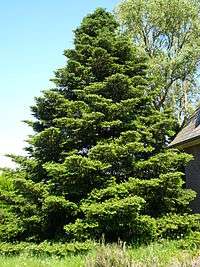Abies koreana
Abies koreana (Korean: 구상나무, Gusang namu), the Korean fir, is a species of fir native to the higher mountains of South Korea, including Jeju Island. It grows at altitudes of 1,000–1,900 metres (3,300–6,200 ft) in temperate rainforest with high rainfall and cool, humid summers, and heavy winter snowfall.
| Korean fir | |
|---|---|
.jpg) | |
| Scientific classification | |
| Kingdom: | Plantae |
| Clade: | Tracheophytes |
| Division: | Pinophyta |
| Class: | Pinopsida |
| Order: | Pinales |
| Family: | Pinaceae |
| Genus: | Abies |
| Species: | A. koreana |
| Binomial name | |
| Abies koreana | |
It is a small to medium-sized evergreen coniferous tree growing to 10–18 m (33–59 ft) tall with a trunk diameter of up to 0.7 m (2 ft 4 in), smaller and sometimes shrubby at the tree line. The bark is smooth with resin blisters and grey-brown in colour. The leaves are needle-like, flattened, 1–2 centimetres (0.4–0.8 in) long and 2–2.5 millimetres (0.08–0.10 in) wide by 0.5 mm (0.02 in) thick, glossy dark green above, and with two broad, vividly white bands of stomata below, and slightly notched at the tip. The leaf arrangement is spiral on the shoot, but with each leaf variably twisted at the base so they lie mostly either side of and above the shoot, with fewer below the shoot. The shoots are green-grey at first, maturing pinkish-grey, with scattered fine pubescence. The cones are 4–7 cm (1.6–2.8 in) long and 1.5–2 cm (0.6–0.8 in) broad, dark purple-blue before maturity; the scale bracts are long, green or yellow, and emerge between the scales in the closed cone. The winged seeds are released when the cones disintegrate at maturity about 5–6 months after pollination.
Cultivation
Korean fir is a popular ornamental plant in parks and gardens in temperate climates, grown for its foliage but also for the abundant cone production even on young trees only 1–2 m (3 ft 3 in–6 ft 7 in) tall. The following have gained the Royal Horticultural Society's Award of Garden Merit:
Gallery


 Leaves
Leaves- Male cones
 Cones and leaves
Cones and leaves In cultivation
In cultivation
References
| Wikimedia Commons has media related to Abies koreana. |
- Kim, Y.-S.; Chang, C.-S.; Kim, C.-S. & Gardner, M. (2011). "Abies koreana". IUCN Red List of Threatened Species. 2011: e.T31244A9618913. doi:10.2305/IUCN.UK.2011-2.RLTS.T31244A9618913.en.
- "A. koreana". Royal Horticultural Society. Retrieved 20 December 2017.
- "A. koreana 'Cis'". Royal Horticultural Society. Retrieved 20 December 2017.
- "A. koreana 'Kohout's Ice Breaker'". Royal Horticultural Society. Retrieved 20 December 2017.
- "A. koreana 'Silberlocke'". Royal Horticultural Society. Retrieved 20 December 2017.
- Liu, T. S. (1971). A Monograph of the genus Abies. National Taiwan University.
